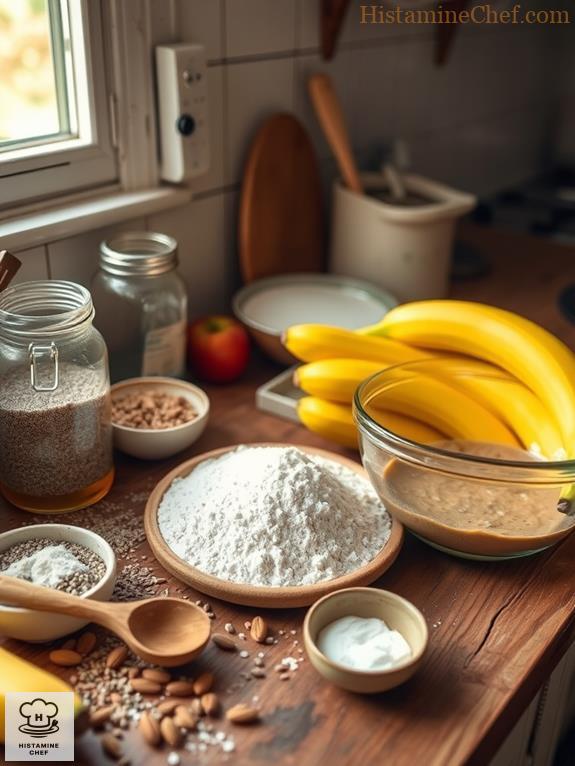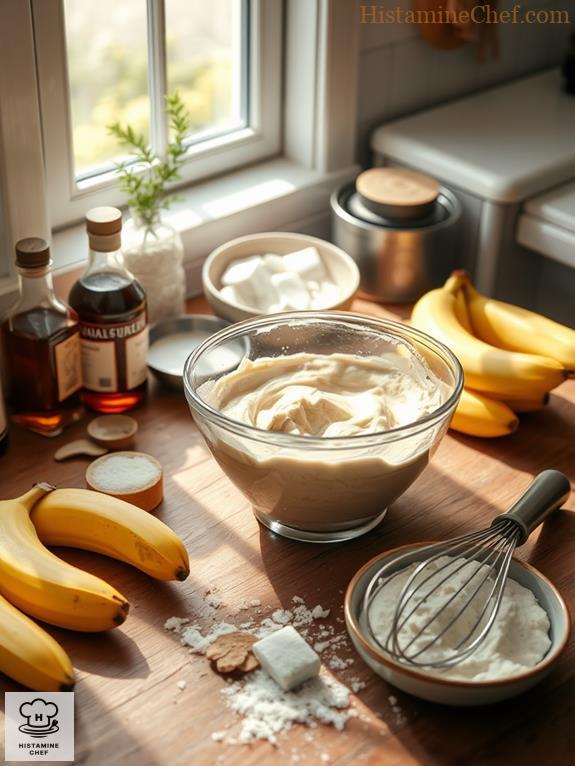Craving yummy treats but battling histamine issues? I've got you covered!
I've been there, desperately searching for ways to satisfy my sweet tooth without triggering reactions. It's been quite the journey!
Through trial and error, I've discovered some game-changing tricks. Baking soda and vinegar? Total lifesavers! And don't get me started on quinoa flour – it's a game-changer.
Sure, sometimes my creations look a bit "rustic," but hey, that's part of the charm, right? Who needs picture-perfect when you've got flavor?
Ready to dive into the world of yeast-free, low-histamine baking? Let's go!
My Hilarious Quinoa Flour Fiasco
So, picture this: Me, excited about my new quinoa flour, deciding to surprise my family with "healthy" cookies. Spoiler alert: It didn't go as planned.
The dough was sticky, the kitchen looked like a flour bomb exploded, and the cookies? Let's just say they were… unique.
But you know what? We laughed, we dunked them in almond milk, and they weren't half bad!
It taught me the importance of experimenting, adjusting ratios, and most importantly, embracing the imperfect journey of alternative baking.
Key Takeaways
- Utilize baking soda and vinegar as effective leavening agents for yeast-free baked goods.
- Opt for low-histamine flours like rice or quinoa to enhance texture and flavor.
- Replace dairy with almond or coconut milk to maintain creaminess without histamine triggers.
- Experiment with natural sweeteners like agave or maple syrup for safe sweetness.
- Adjust baking temperatures and moisture levels when using alternative flours for optimal results.
Alternative Leavening Agents

When it comes to yeast-free baking, exploring alternative leavening agents can make all the difference.
I love using baking soda combined with vinegar reactions to create that delightful rise. It's like a mini science experiment in your kitchen! Just mix a teaspoon of baking soda with a tablespoon of vinegar, and watch the bubbles work their magic.
If you're searching for sourdough alternatives, consider using baking powder substitutes. They can be life-savers for those sensitive to histamine, as long as you choose the right ones.
For low-histamine baking, it's essential to select ingredients that won't trigger reactions while still achieving the desired texture and flavor in your baked goods.
Think about it: who wouldn't want airy pancakes or fluffy muffins without the fuss of yeast? So let's whip up some culinary creativity together!
Here at Histamine Chef, I'm all about making delicious recipes accessible!
Choosing Low-Histamine Ingredients

Choosing low-histamine ingredients is essential for anyone looking to maintain a balanced diet without flare-ups.
I love experimenting with low histamine flours like rice or quinoa for a unique baking experience. These flours not only keep things interesting but also help avoid unwanted reactions.
For those who miss traditional wheat-based baked goods, smart substitutions can help recreate familiar flavors and textures while keeping histamine levels in check.
When it comes to dairy substitutes, almond or coconut milk work wonders. They add creaminess without triggering any histamine chaos.
Consider it—a baking can be delightful! Envision the aroma of freshly baked goodies without the worry.
So, next time you whip up a treat, reach for those low-histamine heroes. Trust me, your taste buds and tummy will thank you!
And that's why I write Histamine Chef—because delicious doesn't have to mean dangerous!
Baking Techniques Without Yeast

Baking techniques without yeast can open up a world of delicious possibilities, especially for those of us following a low-histamine diet.
One of my favorite methods is using baking powder or baking soda as leavening agents. They work wonders! Just keep in mind to adjust your baking temperatures; a little trial and error can lead to perfect results.
Ingredient substitutions can be a game changer too. For instance, if you're using almond flour instead of regular flour, don't forget to add a bit more moisture.
And hey, if your creation doesn't rise perfectly, just call it a "rustic" style!
With these techniques, you can whip up delightful treats without the stress of yeast. Happy baking!
Sweetening Options for Baking

Finding the right sweetener can make all the difference in your baking, especially on a low-histamine diet.
I've discovered that natural sweeteners like agave and maple syrup are game-changers. They add delightful flavors without the histamine headaches! For those missing fermented flavors, these low-histamine alternatives can provide a satisfying depth to your baked goods.
Sugar alternatives like honey and molasses can also work wonders. Picture biting into a warm cookie, sweetened naturally—yum!
Just recall, though, to steer clear of artificial sweeteners and flavored syrups; they can be sneaky troublemakers on the SIGHI list.
Experimenting with these options can make your treats not only safe but also scrumptiously innovative!
So, what're you waiting for? Let's sweeten things up and make baking a breeze together!
I'm all about sharing these ideas on Histamine Chef.
Tips for Successful Low-Histamine Baking

How can we guarantee that our low-histamine baking turns out delicious every time?
First, let's chat about baking temperature control. Preheating your oven is key! If it's not hot enough, your creations might flop. Trust me, I've had a few sad, soggy cakes.
Next, ingredient substitutions can be a game-changer. Swap out high-histamine ingredients for allowed ones from the SIGHI list. For instance, use coconut milk instead of soy!
And don't be afraid to experiment! Trying different herbs and spices can elevate your treats. Just keep in mind, no chili or pepper!
FAQ
Can I Use Baking Soda Instead of Yeast in All Recipes?
I've found that you can often use baking soda as a yeast substitute, but it's essential to adjust the recipe's acidity. Experimenting with baking powder alternatives can lead to delightful, innovative results in your baking!
What Are the Best Storage Methods for Low-Histamine Baked Goods?
For my low-histamine baked goods, I use airtight storage containers to maximize shelf life. Keeping them in a cool, dark place helps maintain freshness, ensuring I enjoy innovative treats without compromising my health.
Are There Pre-Made Low-Histamine Baking Mixes Available?
Have you ever wondered about pre-made low-histamine baking mixes? I've found some innovative options, but I always check ingredient labels carefully. It's crucial to guarantee they align with my dietary needs and preferences.
How Can I Tell if Ingredients Are Truly Low-Histamine?
I always check ingredient sourcing and conduct histamine testing myself. It's essential to guarantee freshness and quality. By staying informed, I can confidently choose low-histamine options for my baking adventures and maintain my health.
Can I Freeze Low-Histamine Baked Items for Later Use?
Absolutely, I freeze my low-histamine baked goods. Using clever freezing techniques, I guarantee texture preservation, so they taste fresh when I defrost them. It's like capturing a moment of deliciousness for later enjoyment!
Summary
I've discovered yeast-free, low-histamine baking can be a delightful adventure. By exploring alternative ingredients and methods, I create treats that are both tasty and gentle on my system. It's a journey of creativity and patience, but the results are worth it.
Have you tried yeast-free, low-histamine baking? Share your experiences and favorite recipes in the comments below. I'd love to hear about your successes and challenges.
If you found this post helpful, please share it on social media. Your support helps Histamine Chef reach more people struggling with histamine intolerance, spreading awareness and helpful information.


Leave a Reply